
The okapi, also known as the forest giraffe, Congolese giraffe, or zebra giraffe, is an artiodactyl mammal that is endemic to the northeast Democratic Republic of the Congo in central Africa. Although the okapi has striped markings reminiscent of zebras, it is most closely related to the giraffe. The okapi and the giraffe are the only living members of the family Giraffidae.
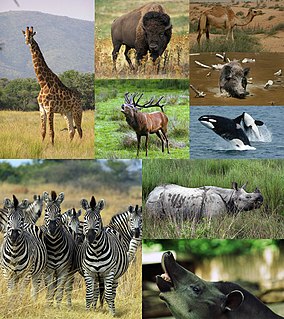
Ungulates are members of the diverse clade Ungulata which primarily consists of large mammals with hooves. These include odd-toed ungulates such as horses, rhinoceroses, and tapirs; and even-toed ungulates such as cattle, pigs, giraffes, camels, sheep, deer, and hippopotamuses. Cetaceans such as whales, dolphins, and porpoises are also classified as even-toed ungulates, although they do not have hooves. Most terrestrial ungulates use the hoofed tips of their toes to support their body weight while standing or moving.

The even-toed ungulates are ungulates—hoofed animals—which bear weight equally on two of their five toes: the third and fourth. The other three toes are either present, absent, vestigial, or pointing posteriorly. By contrast, odd-toed ungulates bear weight on an odd number of the five toes. Another difference between the two is that many other even-toed ungulates digest plant cellulose in one or more stomach chambers rather than in their intestine as the odd-toed ungulates do.

The Giraffidae are a family of ruminant artiodactyl mammals that share a common ancestor with cervids and bovids. This family, once a diverse group spread throughout Eurasia and Africa, presently comprises only two extant genera, the giraffe and the okapi. Both are confined to sub-Saharan Africa: the giraffe to the open savannas, and the okapi to the dense rainforest of the Congo. The two genera look very different on first sight, but share a number of common features, including a long, dark-coloured tongue, lobed canine teeth, and horns covered in skin, called ossicones.

Chevrotains, or mouse-deer, are small even-toed ungulates that make up the family Tragulidae, the only extant members of the infraorder Tragulina. The 10 extant species are placed in three genera, but several species also are known only from fossils. The extant species are found in forests in South and Southeast Asia, with a single species, the water chevrotain, in the rainforests of Central and West Africa. They are solitary or live in pairs, and feed almost exclusively on plant material. Chevrotains are the smallest hoofed mammals in the world. The Asian species weigh between 0.7 and 8.0 kg, while the African chevrotain is considerably larger at 7–16 kg (15–35 lb). With an average length of 45 cm (18 in) and an average height of 30 cm (12 in), the Java mouse-deer is the smallest extant (living) ungulate or hoofed mammal, as well as the smallest extant even-toed ungulate.
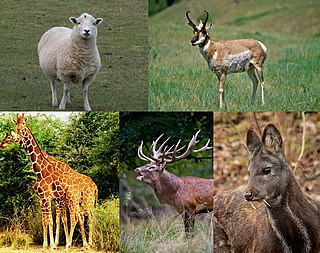
Pecora is an infraorder of even-toed hoofed mammals with ruminant digestion. Most members of Pecora have cranial appendages projecting from their frontal bones; only two extant genera lack them, Hydropotes and Moschus. The name “Pecora” comes from the Latin word pecus, which means “horned livestock”. Although most pecorans have cranial appendages, only some of these are properly called “horns”, and many scientists agree that these appendages did not arise from a common ancestor, but instead evolved independently on at least two occasions. Likewise, while Pecora as a group is supported by both molecular and morphological studies, morphological support for interrelationships between pecoran families is disputed.

The Antilocapridae are a family of artiodactyls endemic to North America. Their closest extant relatives are the giraffids with which they comprise the superfamily Giraffoidea. Only one species, the pronghorn, is living today; all other members of the family are extinct. The living pronghorn is a small ruminant mammal resembling an antelope.

Syndyoceras is a small extinct genus of Artiodactyla, of the family Protoceratidae, endemic to central North America from the Miocene epoch, existing for approximately 4.2 million years.
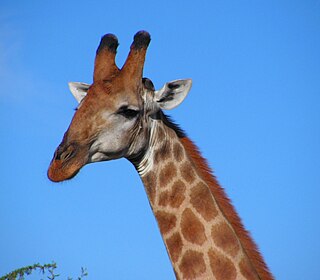
Ossicones are columnar or conical skin-covered bone structures on the heads of giraffes, male okapi, and some of their extinct relatives. Ossicones are distinguished from the superficially similar structures of horns and antlers by their unique development and a permanent covering of skin and fur.

Climacoceras is a genus of extinct artiodactyl ungulates that lived in Africa and Europe during the Miocene. The members of Climacoceras were related to giraffes, and the genus was formerly placed within the Giraffidae, but is now placed in the Climacoceratidae, a sister group within the superfamily Giraffoidea. Fossils of the two best known species of Climacoceras, C. africanus and C. gentryi, have both been found in Kenya. The animals measured about 1.5 m (4.9 ft) tall and had large ossicones resembling antlers. C. africanus had ossicones resembling tall, thorn-covered plant stems, while the ossicones of C. gentryi resembled thorny crescents.
Giraffokeryx is an extinct genus of medium-sized giraffids known from the Miocene of the Indian subcontinent and Eurasia. It is distinguished from other giraffids by the four ossicones on its head; one pair in front of the eyes on the anterior aspect of the frontal bone and the other behind the eyes in the frontoparietal region overhanging the temporal fossae. It has a brachydont dentition like in other giraffids and its legs and feet are of medium length. Giraffokeryx is considered monotypic by most authors, in the form of G. punjabiensis, but other species have been assigned to the genus:

Honanotherium is a genus of extinct giraffid from the late Miocene of Henan Province, China, and East Azerbaijan Province, northwestern Iran. It was closely related to Bohlinia and was once thought to be ancestral to the modern giraffe. The living animal would have resembled a modern giraffe, but was somewhat shorter, with more massive ossicones.
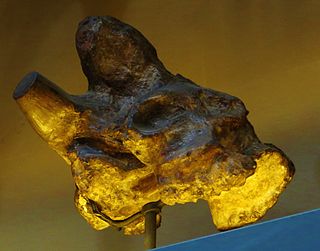
Bramatherium is an extinct genus of giraffids that ranged from India to Turkey in Asia. It is closely related to the larger Sivatherium.
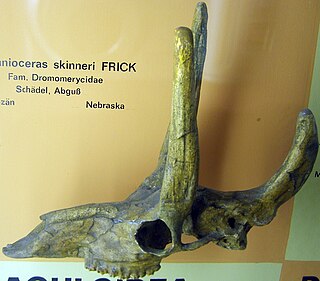
The Palaeomerycidae are an extinct family of ruminants in the order Artiodactyla. Palaeomerycids lived in North America, Europe, Africa and Asia from 33 to 4.9 million years ago, existing for about 28 million years; one species was also reported from South America, but its identity as a palaeomerycid was subsequently disputed.

Samotherium is an extinct genus of Giraffidae from the Miocene and Pliocene of Eurasia and Africa. Samotherium had two ossicones on its head, and long legs. The ossicones usually pointed upward, and were curved backwards, with males having larger, more curved ossicones, though in the Chinese species, S. sinense, the straight ossicones point laterally, not upwards. The genus is closely related to Shansitherium. Fossil evidence suggests that Samotherium had a rounded muzzle, which would suggest a grazing lifestyle and a habitat composed of grassland. One common predator of this animal was the Amphimachairodus

Triceromeryx is an extinct genus of Artiodactyla, of the family Palaeomerycidae, endemic to Europe from the middle Miocene epoch, 16.9—16.0 Ma, existing for approximately 0.9 million years.
Bohlinia is an extinct genus of the artiodactyl family Giraffidae that lived during the Late Miocene in Europe and Africa. It was first named by the paleontologist Dr. W. Matthew in 1929, and contains two species, B. adoumi and B. attica. The species B. attica has been reclassified several times since its description being first named Camelopardalis attica and then reclassified as Giraffa attica.

Giraffoidea is a superfamily that includes the families Climacoceratidae, Antilocapridae, and Giraffidae. The only extant members in the superfamily are the pronghorn, giraffe, and okapi. The Climacoceratidae are also placed in the superfamily, but were originally placed within the family Palaeomerycidae.

Palaeomeryx is an extinct genus of Artiodactyla, of the family Palaeomerycidae, endemic to Europe and Asia from the Miocene epoch, 16.9 – 7.25 Ma, existing for approximately 9.65 million years.

Cervavitus is a genus of prehistoric deer that lived from the late Miocene to the Early Pleistocene in parts of Western and Eastern Europe, Central Asia and China. It is characterized by having thorny antlers finished in two or three points, brachyodont teeth, molars with a primitive fold and complete lateral metacarpals on their feet, which would serve to move through slope areas. Due to its particular position in the systematics and phylogeny of deer, is considered to form part of the first branches of cervids more advanced than the muntiacines, and perhaps is closely related to the branch that would give rise to the modern genus Cervus, although it has traditionally been classified as part of a separate subfamily called Pliocervinae.



















